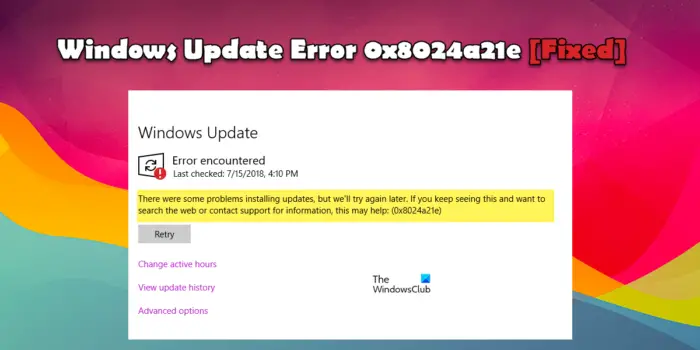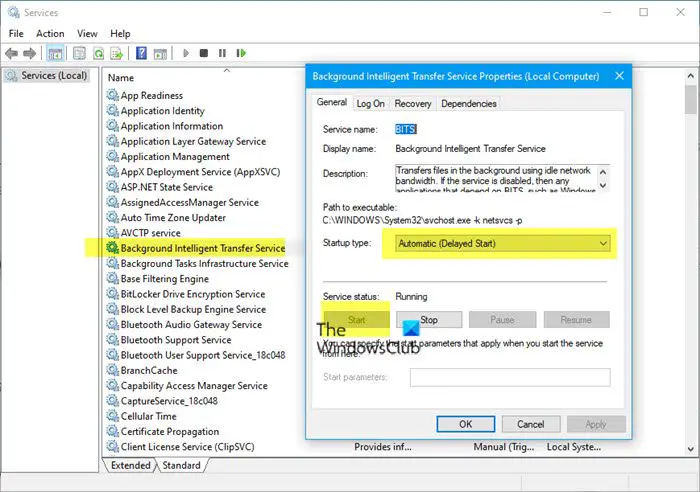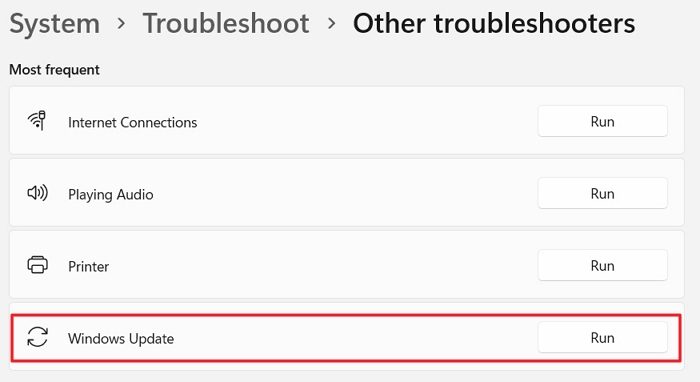When some users try updating their Windows Operating System, they receive Windows Update Error 0x8024a21e. In this post, we will talk about this issue and see what you can do to resolve it. Following is the exact error message users are seeing.
There were some problems installing updates, but we’ll try again later. If you keep seeing this and want to search the web or contact support for information, this may help: 0x8024a21e)

What is Windows Update Error 0x8024a21e?
There are various reasons behind the update error. Most of the time, it is just the fact that Windows Update services are disabled. You can easily enable them the issue will be resolved. However, it is not the only reason, one of the other major causes for the update error is corrupted files. Either your system files are corrupted or the update files are corrupted. The good news is, even they can be repaired and we are going to show how hereinafter.
Fix Windows Update Error 0x8024a21e
If you encounter Windows Update Error 0x8024a21e, try the following solutions and suggestions to resolve the issue.
- Make sure that BITS and Windows Update Services are running
- Start Windows Defender Service
- Run Windows Update Troubleshooter
- Clear Software Distribution folder and Catroot folder
- Reset Windows Update Component
- Manually download the update from Microsoft Update Catalog website.
Let us talk about them in detail,
1] Make sure that BITS and Windows Update Services are running

First of all, we need to make sure that Background Intelligent Transfer Service and Windows Update Service are running in the background. These services allow the user to download Windows Update, if they are disabled, the error code in question will appear. So, to enable it, open Services from the Start Menu. Look for Background Intelligent Transfer Service (BITS), right-click on it, and select Properties. Change the Startup type to Automatic and click on the Start button if it is stopped. Now, do the same with Windows Update Service. Finally, check for updates and see if the issue is resolved.
2] Start Windows Defender Service
If you have any third-party antivirus software and firewall installed, temporarily disable them and make sure that the Windows Firewall is turned on.
- Now open Services Manager and locate Windows Defender service in the services list.
- Verify that the Status is Started.
- If the Status column is blank,right click on the service and select Start.
- If you get error trying to force start the Windows Defender service, try to change the Startup Type to Automatic, and then restart the computer.
Now see if you can install Windows Updates.
3] Run Windows Update Troubleshooter

Next up, let us deploy the Windows Update Troubleshooter, which is a built-in utility that will scan what’s wrong with your Windows and prompt you to allow it to fix those issues. So, since we are having trouble with the same, why not use it to repair the cause? If you want to use the Windows Update troubleshooter, follow the prescribed steps.
Windows 11
- Hit Win + I to open Settings.
- Go to System.
- Click Troubleshoot.
- Then, click on the Run button associated with Windows Update.
Windows 10
- Open Settings.
- Go to Update & Security > Troubleshoot > Additional troubleshooter.
- Click on Windows Update and then select Run this troubleshooter.
Hopefully, this will do the trick for you. If the troubleshooter failed to recognize and resolve the issue, move to the next solution.
4] Clear Software Distribution Folder and Catroot folder
The Software Distribution folder contains information about Windows Update. However, if the folder gets corrupted, you will not able to check for updates and when doing so, error code 0x8024a21e will appear. In order to resolve the issue in this case, first of all, we need to stop some services. To do the same, open the elevated Command Prompt window. Then, execute the following commands.
net stop wuauserv
net stop bits
net stop cryptSvc
net stop msiserver
After executing the commands, open File Explorer and go to C:\Windows\SoftwareDistribution. Next, delete all files and folders inside the SoftwareDistribution folder. Now, do the same to C:\Windows\System32\catroot2. There is nothing to worry about as all the files will be created next time you check for updates.
After deleting the content of the SoftwareDistribution folder, we need to restart the services we stopped earlier. So, launch CMD as an administrator and run the following commands.
net start wuauserv
net start bits
net start cryptSvc
net start msiserver
After completing all the steps, reboot your computer and check if the issue persists.
5] Reset Windows Update Component
Software Distribution folder is not the only Windows Update component that you need to reset, although it is the most important and vulnerable one. So, if after clearing the Software Distribution folder, your issue persists, reset Windows Update Components using our guide and see if that helps. Hopefully, this will flush out the corrupted fragment of Windows Update to resolve the issue error code in question.
Read: Reset Windows Update Tool will restore settings & components to the default
6] Manually download the update from Microsoft Update Catalog
You can try downloading the updates from Microsoft Update Catalog, which is a Microsoft website containing all the Windows updates. You can visit catalog.update.microsoft.com, enter the update code that you were trying to install and download the .msu file. Once the file is downloaded, just double-click on it and follow the on-screen instruction to complete the installation process. Keep in mind that this is not a solution, instead, it is a workaround.
Read: Fix Windows Update Errors 0x800705b4
We hope that you can resolve the issue using the solutions mentioned in this post.
How to fix Windows Update not installing?
If Windows Update is not installing or downloading, you can try the solutions mentioned in this post. Most of the Windows Update errors are similar and sometimes, can be resolved by simple solutions. However, we would recommend you check our guide to see what to do when Windows Updates are not installing or downloading on your computer.
Also Read: Windows Cumulative Update not installing or failing to install.
Leave a Reply